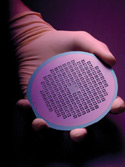


Super-Thin Filter Points to New Possibilities

A porous membrane more than 4,000 times thinner than a human hair may revolutionize the way doctors and scientists manipulate objects as small as a molecule. It opens the possibility for better dialysis, fuel cells, and neuronstem cell cultivation.
Research associate Christopher Striemer discovered the membrane in the lab of Professor Philippe Fauchet while investigating how silicone crystallizes when heated. Assistant Professor James L. McGrath and graduate student Tom Gaborski realized the membrane’s tiny holes might be able to separate objects as small as proteins.
The team also found a way for the nanofilter to carry a fixed charge, effectively making the hole “smaller” for certain molecules—a boon for fuel cell researchers.
“We think we can engineer these membranes to provide superior discrimination of proteins, which may make the process of dialysis faster and more effective than it is today,” says McGrath. Johnson & Johnson recently gave a $100,000 grant to support the effort.
The researchers have founded a company, SiMPore, to commercialize applications of the nanomembrane and have already been approached by semiconductor giants such as Intel about its use.
